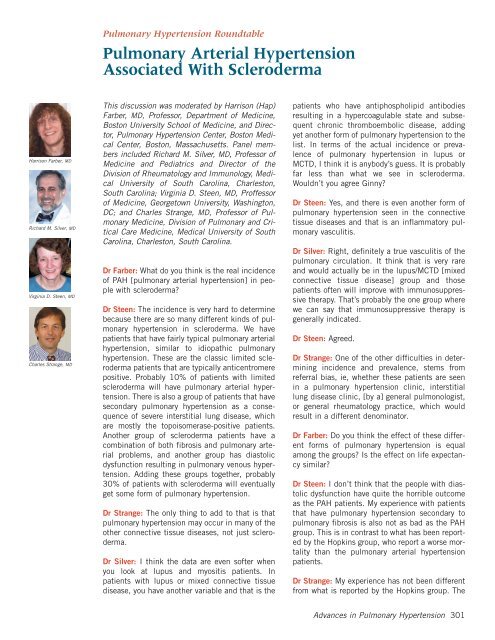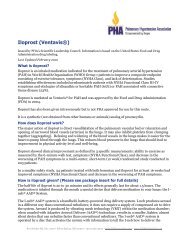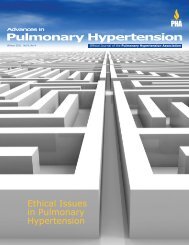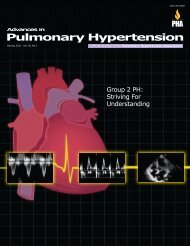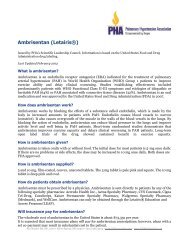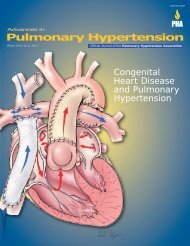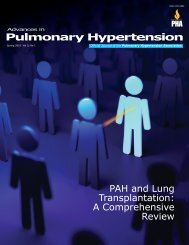Pulmonary Hypertension - PHA Online University
Pulmonary Hypertension - PHA Online University
Pulmonary Hypertension - PHA Online University
Create successful ePaper yourself
Turn your PDF publications into a flip-book with our unique Google optimized e-Paper software.
<strong>Pulmonary</strong> <strong>Hypertension</strong> Roundtable<strong>Pulmonary</strong> Arterial <strong>Hypertension</strong>Associated With SclerodermaHarrison Farber, MDRichard M. Silver, MDVirginia D. Steen, MDCharles Strange, MDThis discussion was moderated by Harrison (Hap)Farber, MD, Professor, Department of Medicine,Boston <strong>University</strong> School of Medicine, and Director,<strong>Pulmonary</strong> <strong>Hypertension</strong> Center, Boston MedicalCenter, Boston, Massachusetts. Panel membersincluded Richard M. Silver, MD, Professor ofMedicine and Pediatrics and Director of theDivision of Rheumatology and Immunology, Medical<strong>University</strong> of South Carolina, Charleston,South Carolina; Virginia D. Steen, MD, Proffessorof Medicine, Georgetown <strong>University</strong>, Washington,DC; and Charles Strange, MD, Professor of <strong>Pulmonary</strong>Medicine, Division of <strong>Pulmonary</strong> and CriticalCare Medicine, Medical <strong>University</strong> of SouthCarolina, Charleston, South Carolina.Dr Farber: What do you think is the real incidenceof PAH [pulmonary arterial hypertension] in peoplewith scleroderma?Dr Steen: The incidence is very hard to determinebecause there are so many different kinds of pulmonaryhypertension in scleroderma. We havepatients that have fairly typical pulmonary arterialhypertension, similar to idiopathic pulmonaryhypertension. These are the classic limited sclerodermapatients that are typically anticentromerepositive. Probably 10% of patients with limitedscleroderma will have pulmonary arterial hypertension.There is also a group of patients that havesecondary pulmonary hypertension as a consequenceof severe interstitial lung disease, whichare mostly the topoisomerase-positive patients.Another group of scleroderma patients have acombination of both fibrosis and pulmonary arterialproblems, and another group has diastolicdysfunction resulting in pulmonary venous hypertension.Adding these groups together, probably30% of patients with scleroderma will eventuallyget some form of pulmonary hypertension.Dr Strange: The only thing to add to that is thatpulmonary hypertension may occur in many of theother connective tissue diseases, not just scleroderma.Dr Silver: I think the data are even softer whenyou look at lupus and myositis patients. Inpatients with lupus or mixed connective tissuedisease, you have another variable and that is thepatients who have antiphospholipid antibodiesresulting in a hypercoagulable state and subsequentchronic thromboembolic disease, addingyet another form of pulmonary hypertension to thelist. In terms of the actual incidence or prevalenceof pulmonary hypertension in lupus orMCTD, I think it is anybody’s guess. It is probablyfar less than what we see in scleroderma.Wouldn’t you agree Ginny?Dr Steen: Yes, and there is even another form ofpulmonary hypertension seen in the connectivetissue diseases and that is an inflammatory pulmonaryvasculitis.Dr Silver: Right, definitely a true vasculitis of thepulmonary circulation. It think that is very rareand would actually be in the lupus/MCTD [mixedconnective tissue disease] group and thosepatients often will improve with immunosuppressivetherapy. That’s probably the one group wherewe can say that immunosuppressive therapy isgenerally indicated.Dr Steen: Agreed.Dr Strange: One of the other difficulties in determiningincidence and prevalence, stems fromreferral bias, ie, whether these patients are seenin a pulmonary hypertension clinic, interstitiallung disease clinic, [by a] general pulmonologist,or general rheumatology practice, which wouldresult in a different denominator.Dr Farber: Do you think the effect of these differentforms of pulmonary hypertension is equalamong the groups? Is the effect on life expectancysimilar?Dr Steen: I don’t think that the people with diastolicdysfunction have quite the horrible outcomeas the PAH patients. My experience with patientsthat have pulmonary hypertension secondary topulmonary fibrosis is also not as bad as the PAHgroup. This is in contrast to what has been reportedby the Hopkins group, who report a worse mortalitythan the pulmonary arterial hypertensionpatients.Dr Strange: My experience has not been differentfrom what is reported by the Hopkins group. TheAdvances in <strong>Pulmonary</strong> <strong>Hypertension</strong> 301


